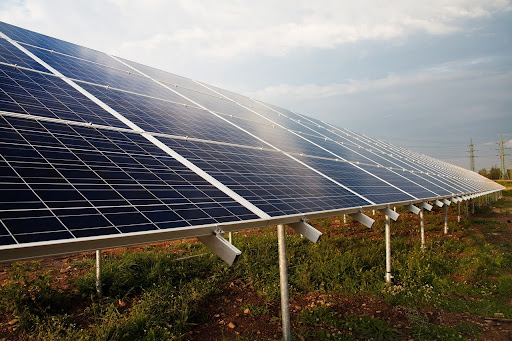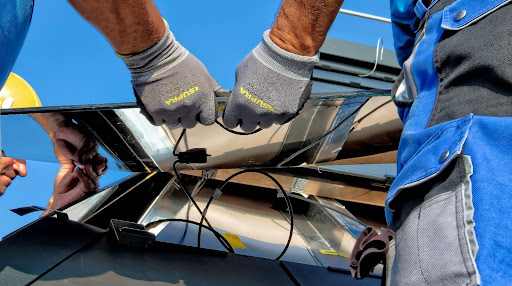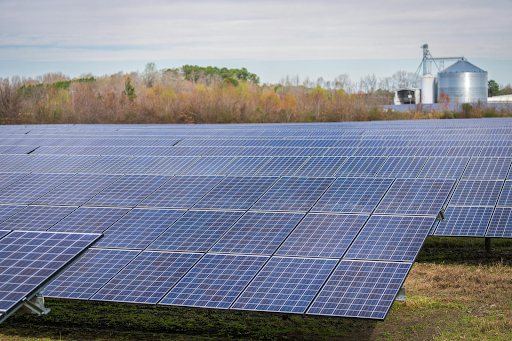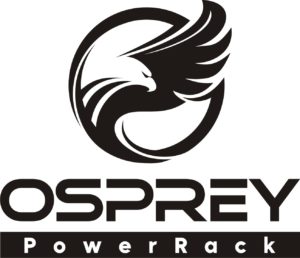Key Takeaways
- Driven pile foundations provide a stable base for solar panels.
- They are particularly cost-effective and adaptable in large-scale solar farms, commercial projects, and residential applications.
- Initial installation costs depend on factors such as soil conditions and project size.
- Nuance Energy’s Osprey PowerRACK® is an innovative alternative, with a faster, more cost-effective installation.
Driven Pile Foundations for Solar Installations

Driven pile foundations provide robust, stable and durable support for solar panels.
Driven pile foundations are a type of deep foundation that involves driving long, slender columns, usually made of steel or concrete, into the ground. This method is highly effective in providing the necessary support for solar panels, especially in areas with variable soil conditions, including sandy, clayey, and rocky soils.
Driven piles are typically pre-manufactured and come in various lengths and diameters, allowing them to be customized to suit different project requirements. The installation process involves using a pile driver, a machine that hammers the piles into the ground, ensuring they reach a stable layer of soil or rock.
| Nuance Energy is your superior solution for Ground Mount solar. Our patented foundation technology Osprey PowerRACK® allows for rapid installation using only handheld tools, significantly reducing both time and costs compared to traditional racking systems. This cutting-edge technology works for residential and commercial installations, and Nuance Energy empowers solar installers to take back control of their installation schedules, control project COGS, gain market share, increase the speed of installation, and reduce the cost of labor. In contrast, a traditional ground mount is much more unpredictable, slower, and costly.
Find out how Nuance Energy can accelerate your solar projects with the Osprey PowerRACK® line, and boost your profitability. Contact us today to discuss our innovative ground-mount solutions. |
The Costs of Driven Pile Foundations
Initial Installation Costs
The initial installation costs for driven pile foundations vary based on several factors, including soil conditions, project size, and geographical location.
In areas with challenging soil conditions, such as rocky or highly compacted soils, additional costs may be incurred due to the need for specialized equipment or techniques. However, the efficiency and speed of the installation process often offset these additional expenses.
The ability to deploy solar projects in diverse locations without extensive site preparation can result in lower overall project costs. This flexibility is particularly advantageous for large-scale solar farms that require significant land areas.
Maintenance Costs
The stability and durability provided by these foundations reduce the need for maintenance and repairs, leading to cost savings over the lifespan of the solar installation.

Unlike concrete foundations, driven piles do not require curing time, enabling immediate panel installation.
Cost Comparison with Other Foundation Types
When compared to other foundation types, driven pile foundations often offer a more cost-effective solution. Concrete footings, for example, require extensive site preparation and curing time, leading to higher labor and material costs.
In contrast, driven piles can be installed quickly and with minimal disruption to the site, resulting in lower overall costs. Additionally, the adaptability of driven piles to various soil conditions means that they can be used in locations where other foundation types may not be feasible.
Common Use Cases for Driven Pile Foundations in Solar
Utility-Scale Solar Farms
Utility-scale solar farms, which often span hundreds of acres, require a foundation solution that is both cost-effective and capable of supporting large numbers of solar panels. Driven pile foundations are ideal for these projects due to their scalability and quick installation process.
Commercial Solar Installations
In commercial solar installations, driven pile foundations also provide a reliable and cost-effective solution. These projects often involve the installation of numerous solar panels on rooftops or open land, requiring a foundation that can support significant weight while ensuring stability. Driven piles are particularly advantageous in commercial settings because they can be installed quickly, minimizing disruptions to business operations.
Moreover, the adaptability of driven piles to various soil conditions means that commercial solar installations can be deployed in a wide range of locations, from urban environments to rural areas.

Driven piles can support significant loads, making them ideal for heavy structures like solar panel installations.
Residential Solar Applications
Driven pile foundations are also a cost-efficient choice for residential solar applications, offering homeowners a stable and durable foundation for their solar panels. In residential settings, the installation process is often straightforward, with minimal site preparation required.
Key Advantages of Using Driven Pile Foundations
Efficiency and Speed of Installation
One of the most significant advantages of driven pile foundations is their efficiency and speed of installation. The use of pile drivers allows for quick and accurate placement of piles, reducing the time required for foundation installation.
Adaptability to Various Soil Conditions
Driven pile foundations are highly adaptable to different soil conditions, including sandy or clayey terrains. By eliminating the need for extensive site preparation, driven piles reduce the overall cost and complexity of solar installations.
Environmental Benefits
In addition to their technical advantages, driven pile foundations offer environmental benefits that align with the goals of renewable energy projects. The installation process for driven piles is less disruptive to the surrounding environment compared to other foundation types, such as concrete footings.
Furthermore, driven piles can be made from recyclable materials, further reducing the environmental impact of the project.
Potential Drawbacks of Driven Pile Foundations
Challenges in Rocky Terrain
While driven piles can be adapted to various soil conditions, rocky terrain may necessitate additional time and resources to ensure a stable foundation. The presence of rocks and boulders can hinder the penetration of piles, requiring specialized equipment or techniques to overcome these obstacles.
Regulatory and Permitting Hurdles
Driven pile foundations, like any construction component, must adhere to local regulations and permitting requirements. These rules ensure that the installation does not negatively impact the environment or community. The permitting process can often be long and complex.
Nuance Energy’s Osprey PowerRACK®, with its earth anchor foundation, is a less invasive alternative that allows for significant cost reductions on labor and the installation process. Additionally, it also does not require any geotechnical reports and installation can be completed within a day. Our technology offers real-time testing and code-compliant reports, simplifying project approvals by ensuring adherence to jurisdictional requirements.
Noise and Vibration Concerns
The installation of driven pile foundations involves the use of pile drivers, which can generate significant noise and vibration. These disturbances may impact nearby communities or sensitive environments, necessitating measures to mitigate their effects.
| Pros | Cons |
| Cost-Effective for Large Projects | Requires Specialized Equipment |
| Fast Installation Process | Noisy Installation |
| No Cure Time Needed | Risk of Structural Damage |
| Effective in Cohesive Soils | Not Suitable for Loose Soil Conditions |
| High Load-Bearing Capacity | Depth Challenges in Installation |

Driven pile foundations offer excellent stability in various conditions, but understanding the specific environmental challenges of your site will help tailor foundation design to meet these demands.
Considerations and Recommendations
Evaluating Project Needs and Environmental Conditions
Factors such as soil conditions, site location, and project size will influence the suitability of driven piles as a foundation solution. Conducting thorough site assessments and soil tests will provide valuable insights into the most appropriate foundation type for your solar installation.
Environmental conditions, such as wind and seismic activity, should also be considered.
Balancing Costs and Benefits
Consider factors such as reduced maintenance needs, adaptability to diverse soil conditions, and the potential for quicker project completion. These benefits can offset the initial investment and contribute to the overall success of your solar project.
Future Trends in Solar Foundations
Innovations in materials and installation techniques will likely enhance the performance and cost-effectiveness of driven pile foundations. Additionally, as renewable energy becomes more mainstream, regulatory frameworks may adapt to support faster and more efficient project approvals.
Why Choose Nuance Energy’s Osprey PowerRACK® System?
Nuance Energy’s Osprey PowerRACK® presents an excellent alternative to driven pile foundations due to its innovative earth anchor technology. Unlike traditional systems that require extensive site preparation and heavy machinery, the Osprey PowerRACK® can be installed quickly and easily with basic hand-held tools. This streamlined installation process reduces labor costs and minimizes disruptions at the site, making it ideal for projects with tight timelines.
Our system is adaptable to various soil conditions and terrains, ensuring stable support for solar panels without the complications often associated with driven pile foundations. Its flexibility allows for real-time adjustments during installation, accommodating different site challenges while maintaining high efficiency.
This allows solar developers to enhance project profitability, minimize installation delays, and achieve a more sustainable solution that aligns with modern energy goals.
Ready to get started?
Contact us to learn more about our solar racking systems and get a quote for your upcoming project.
Frequently Asked Questions (FAQ)
What are the benefits of using driven pile foundations for solar panels?
Driven pile foundations provide a stable and durable base for solar panels, ensuring they remain securely anchored in various environmental conditions. They offer quick installation, adaptability to different soil types, and reduced maintenance needs.
How do the costs of driven pile foundations compare to other types?
Driven pile foundations are generally more cost-effective than other foundation types, such as concrete footings. Their quick installation and adaptability to various soil conditions reduce overall project costs.
In what environments are driven pile foundations most effective?
Driven pile foundations are highly adaptable and can be used in a wide range of environments, including sandy, clayey, and rocky soils. Their versatility makes them suitable for both urban and rural solar projects, as well as utility-scale solar farms and residential installations.
What are good alternatives to driven pile foundations?
A great alternative to driven pile foundations is our Osprey PowerRACK® racking system. It utilizes our patented earth anchor technology, allowing for faster installation without the need for concrete or heavy machinery. Additionally, the Osprey PowerRACK® minimizes environmental impact and reduces costs.
Save Time & Money on Your Next Solar Project
Request a QuoteRECENT POSTS
- DPW Solar vs Nuance Energy Mounted Solar Options: Cost & Benefits
- Geotechnical Report Cost & Requirements For Solar Projects
- Are Solar Panels Worth It In Nevada? Costs & Options
- OSPREY PowerRack Ground Mount System Compatibility: Single- and Dual-Axis Trackers
- Rammed Earth Foundation For Solar Arrays: Cost, Pros & Cons
- Agrivoltaics Explained: Solar & Agriculture Combined
- Large Scale Solar Systems Options: Pros & Cons
- Best Solar Options For Farms & Agriculture: Cost, Pros & Cons
- Unirac vs MT Solar Mounted Options: Cost & Benefits
- IronRidge vs Grengy Mounted Solar Options: Cost & Benefits

